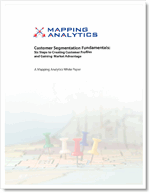Customer Profiling Information
- Customer Profiling Overview
- Benefits of Customer Profiling
- Applying Customer Profiles
- Consumer Surveys & Research
Related Topics
Resources
In-Store Consumer Surveys
Affordable research & data collection using in-store kiosks
Using in-store self-service kiosks to survey consumers can save 25-50% off traditional data collection methods.
Mapping Analytics has a new data collection program allowing retailers to place an unattended kiosk in a store to collect consumer intercept survey responses through a wireless Internet connection, making consumer research affordable.
Benefits of In-Store Kiosks for Consumer Research
- Savings of 25-50% in data collection costs on large scale or lengthy projects.
- Kiosks can stay in place for as long as needed to collect appropriate data set.
- Adhere to privacy laws by allowing consumers to click a map showing their location rather than revealing personal address information.
Affordable Consumer Research Program
- Standalone, full-sized kiosks that provide stability, security, and Internet access.
- Survey design services to help craft appropriate questions and sequences to gather data appropriate to the client’s analytic objectives.
- A mapping application integrated with the survey that allows consumers to click on the map to show their point of origination, residence or subsequent destination, providing valuable location and trip data for store impact analysis.
- Leasing of kiosks and Internet connections through Mapping Analytics (or client can supply their own).
- Remote access to survey results and real-time monitoring of the data collection process.
- Project management / logistic services.
Key Uses of Consumer Research
With consumer intercept research now affordable, retailers can use data collected to support or make key strategic decisions:
New Site Evaluation / Sales Forecasting
Site evaluation and sales forecasting require large samples of consumer data and an understanding of typical trip patterns and where customers come from — data that can be easily collected using kiosks.
Store Impact Analysis
Consumer data and travel patterns help retailers understand the potential impact of a new store on the current market. The sales potential for a new store and sales transfer from existing stores can be modeled based on various store network and consumer demand scenarios.
Product and Service Research
Retailers can use kiosks to solicit consumer feedback on everything from new products offered in the store to new seating arrangements, décor or service policies.
Customer Satisfaction Research
Data collected from kiosks can fuel ongoing, longitudinal studies that measure customer satisfaction and attitudes, brand strength and attributes, and shifts in consumer preferences and behavior.
Typical Consumer Research Programs
Most consumer research projects using on-site kiosks will fit into one of three categories:
- Large scale, multi-store (>25) within a limited timeframe. Data from this type of project is collected in a short interval and most likely used for modeling purposes or to analyze initial customer responses to product or services introductions.
- Large scale, multi-store (>25) with no set timeframe. Ongoing data collection to support site selection, network analysis or to gather a larger data set to understand consumer attitudes.
- Small scale, single or few stores. Gather data for store impact analysis, with fewer time constraints and project management costs.
Deployment Process
Mapping Analytics has defined a straightforward deployment process to help ensure the success of kiosk data collection programs. The steps include:
Logistics
- Determine number of completed surveys needed
- Identify locations to be surveyed
- Estimate time required
Survey implementation
- Develop and program survey
- Integrate with logistics plan
Execution
- Kiosk shipment and setup
- Survey supervision
Database development
- Screening of collected data
- Database delivery
Next Steps
- To get started with in-store consumer intercept surveys and consumer research, contact Mapping Analytics at (877) 893-6490.
Consumer Research Brochure
Affordable data collection and surveying using in-store kiosks and the Internet.
White Paper
Customer Segmentation Fundamentals
Discover the six steps to creating customer segmentation profiles and using them to gain marketing advantage.
Download

